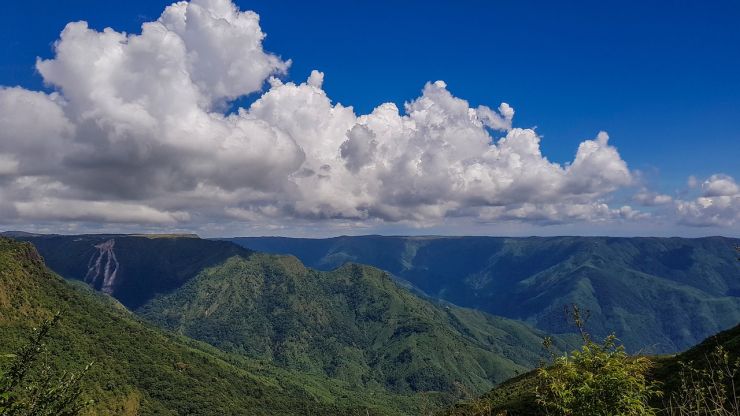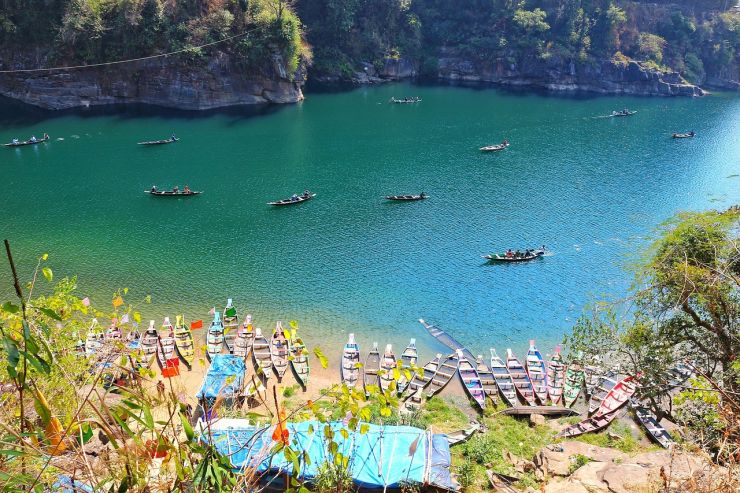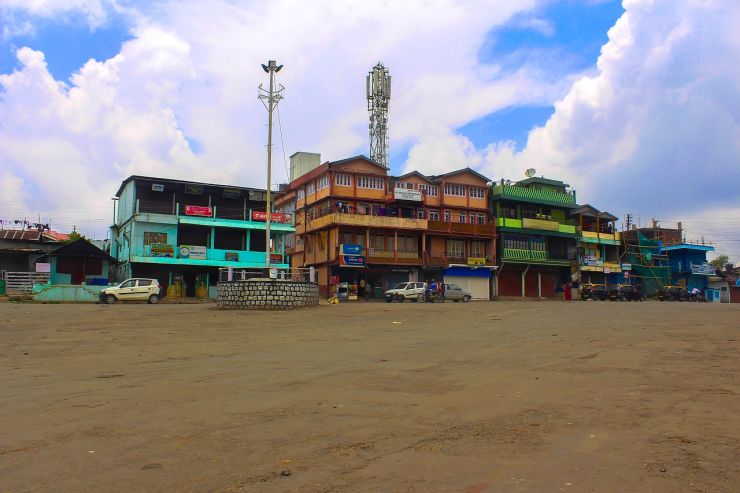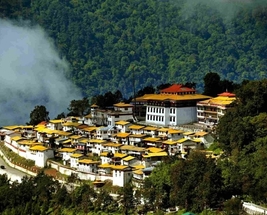Meghalaya is heaven on earth with its lush valleys, pristine waterfalls and otherworldly views in the monsoon. Be it the comfortably warm days in the summer or the beautiful cherry blossom trees in their full prime in autumn, the decision as to when to head to this state is yours.
The weather plays an extremely important role in deciding when to visit your chosen holiday destination. We, at Thomas Cook, will help you reach an informed decision by telling you what each season has in store for you. The ideal time to travel can only be decided once you weigh all the pros and cons of each season. We have also listed down the precautionary measures that you must take before you head out; be it summer, monsoon, autumn or winter.
Take a look!
Peak Season – Temperatures range from 16°C and 31°C in the peak season. This is between the months of April and June. The agreeable weather allows you to head outdoors and explore the hamlet. Summer in Meghalaya lets you enjoy the best of both worlds. Be it relaxing with your family indoors or heading out on an adventure.
Shoulder Season – November to March
Low Season – July to October
|
Travel Seasons
|
Min/Max Temperature
|
Season
|
|
April to June
|
15-25 °C
|
Pleasantly warm
|
|
July to September
|
24-33°C
|
Moderate to heavy rainfall
|
|
October to November
|
22 to -29 C
|
Cool and humid
|
|
December to February
|
4 – 16 C
|
Winter - Cold winds and misty mornings
|
Most Popular Meghalaya Tour Packages
Meghalaya in Summer (April– June)
Temperature - The air temperature during summer fluctuates between 16°C and 31°C.
Weather – The sun kisses this showery state, making this time of the year perfect for explorers. The comfortably warm weather lets you satisfy your curiosity as you venture outdoors and explore the region. This makes the summer season the best time to visit Meghalaya in. With the area being rainy, the skies are constantly cloudy and overcast throughout the day, making it an excellent time to engage in some adventure activities and best time to visit Meghalaya. The afternoons can get a little muggy and hence you could retire indoors and relax during that time.
Significant events – This time of the year is not only best suited for the adventure seekers and explorers, but also those who want to learn about the culture of this hamlet. Summer is the time when most festivals and events are celebrated, bringing locals and tourists from all walks of life closer together. The highlight of this season is the three-day festival of Shad Suk Mynsiem held in April. This festival celebrates the spirit of the Khasi tribe and is better known as the Dance of Contentment. It is an annual thanksgiving dance by the Khasi tribe performed in hopes of the Bumper harvest. Clad in traditional fineries, the locals dance to the beats of drums and pipes called tangmuri which is known to be the queen of musical instruments
Why you should visit now – There will never be a dull moment in Meghalaya at this time of the year. Bustling with people and activity, most festivals are celebrated in the summer. The pleasant weather also makes it the best time to engage in some sightseeing and adventure activities. You could head to the Living Root Bridges found deep in the dense tropical forests. The bridge, Meghalaya’s most famous attraction, is tucked away and hidden by the rains and clouds for a major part of the year. These bridges have been trained by the Khasi tribe to grow from the roots of old rubber trees from the northeast region. You could also go trekking and camping or just set up a quiet picnic with your family.
Things to know before the visit –With it being a rainy region, be mindful of the roads while travelling, as the hilly terrain could get wet and slippery. At the same time, since it is the summer season, try not to expose your skin to the sun for a long time.
Tips – Be wary of the crowd during the peak season and book your tickets well in advance. Plan your activities and itinerary according to the weather. While you pack, make sure you include both warm and cool clothes as well as sunscreen and sunglasses.
Meghalaya in Monsoon (July – September)
Temperature - The air temperature during the season of monsoon ranges between 24°C and 33°C.
Weather – The state is drenched in showers of rain at this time of the year. Meghalaya also boasts of two of the rainiest cities in the world - Cherrapunjee and Mawsynram. This makes monsoons the ideal time to stay put in the hills and enjoy a hot beverage as you snuggle into a blanket with your family. Going out and exploring the area is not recommended at this time of the year. However, the region makes up for the fact with misty mornings, dewy and lush meadows and waterfalls that beat down ever so relentlessly on the rocks.
Significant events – The rains at this time of the year layer the hamlet with an aura of mystique and another worldly charm. Hence, the highlight of this season is Behdienkhlam, which is widely celebrated in the north-eastern state of Meghalaya. Translated as chasing away the demon of cholera, Behdienkhlam marks the victory of good over evil. As the hamlet awaits the rains, locals gather to cook and relish delicious food, participate in dances, music and sports every July.
Why you should visit now – If you are looking to kick back, relax and revel in the beauty of this rainy state with your family, this is the best time of the year to visit. Translated to ‘the abode of clouds,’ Meghalaya’s lush, green valleys and tranquil villages stand testament to the same. Listen to the water gushing ever so harmoniously at the Elephant Falls as it slips down the rocks. With the tourist season being rather lean, you can enjoy the drizzly beauty of Meghalaya away from the crowd.
Things to know before the visit – Do check the weather reports before booking your tickets and accommodation. Plan your itineraries and things to take accordingly. With it being the offseason, do watch out for some discounts on tickets. You may not be able to visit quite a few spots because of the rain, hence plan your trip accordingly.
Tips – Carry waterproof clothes, mosquito repellents and sports shoes. Wear a raincoat or carry an umbrella when you venture out. Be mindful of the roads while traveling and stay alert.
Meghalaya in Autumn (October – November)
Temperature - The air temperature during autumn fluctuates between 22°C and 29°C.
Weather – The relentless showers leave the weather of Meghalaya in autumn cold, wet and humid. The wet state is dotted with cherry blossom trees that are in full bloom at this time of the year. The temperatures start to dip with the winter season being just around the corner.
Significant events – Quite a few festivals are lined up at this time of the year to attract tourists from all over the country. One of the main festivals to highlight and celebrate the onset of this season is the Autumn festival that takes place in the capital of Meghalaya, Shillong. Held in October, this event showcases the spirit and rich culture of the region. Tourists will get to participate in a various event such as the food and wine festival, musical performances and flower shows.
Why you should visit now – This is the perfect time to witness the beauty of the state in its prime. Autumn also brings with it, mesmerising cherry trees in full bloom. Adorned with pink and white flowers in this season, you will almost feel like you are in a Japanese garden.
Things to know before the visit – With the tourist season slowly increasing, make sure you book your tickets well in advance.
Tips – Carry light woollens at all times to keep yourself warm since the winters are just around the corner.
Meghalaya in Winter (December – February)
Temperature - The air temperature during winter ranges between 4°C and 16°C.
Weather – The weather of winter in Meghalaya is comfortably cold. As the days go by, temperatures dip further. However, the days are quite warm because of the sun and the night-time brings with it some cold winds. The month of December is not as cold as compared to January and February. The weather, however, remains clear.
Significant events – The winters mark the beginning of Christmas and New Year festivities. However, the events that take place in Meghalaya do not just end with a countdown to the new year. The Strawberry Festival takes place every year to celebrate and promote farmers and food produced from the fruit. Meghalaya has a conducive climate allowing the growth of the fruit. The hamlet’s language of love is not expressed with roses, but lush and sweet strawberries on Valentine’s Day.
Why you should visit now – If you want to wake up to foggy mornings and spend the day exploring the hamlet, you must visit at this time of the year. Playing indoor games with your family or spending the day outside, this cosy weather is suitable for both. This weather also allows you to go on trekking expeditions and explore neighbouring places such as Shillong, Tura and Guwahati. You can also visit attractions like Balpakram National Park and the Living Route Bridge.
Things to know before the visit – Book your tickets well in advance and try to visit in December since January to March tend to be a lot colder.
Tips – Do carry woollen clothes, jackets, shawls and mufflers to keep yourself warm.
Want to pack your bags right away to rush to this rainy heaven? Visit our website and go through the Meghalaya packages that we offer. Contact us right now to book your Meghalaya Tour Packagesand accommodation!



























